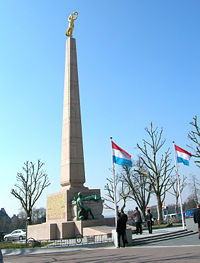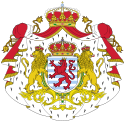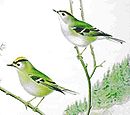
National symbols of Luxembourg
Encyclopedia





Luxembourg
Luxembourg , officially the Grand Duchy of Luxembourg , is a landlocked country in western Europe, bordered by Belgium, France, and Germany. It has two principal regions: the Oesling in the North as part of the Ardennes massif, and the Gutland in the south...
or its people in either official or unofficial capacities.
Note that, under Luxembourgian law, the term 'national emblem' is a strictly-defined term that refers to only four of Luxembourg's official symbols of the state: the national anthem
Ons Hémécht
"Ons Heemecht" is the national anthem of Luxembourg. The title in Luxembourgish translates as Our Homeland. Michel Lentz wrote the words in 1859, and they were set to music by Jean Antoine Zinnen in 1864...
, the national flag
Flag of Luxembourg
The flag of Luxembourg consists of three horizontal stripes, red, white and blue, and can be in 1:2 or 3:5 ratio. It was first used between 1845 and 1848 and officially adopted on June 23, 1972....
, the national coat of arms
Coat of arms of Luxembourg
The coat of arms of Luxembourg has its origins in the Middle Ages, and was derived from that of the Duchy of Limburg, in modern day Belgium and the Netherlands...
, and the national civil ensign
Civil ensign
The civil ensign is the national flag flown by civil ships to denote nationality...
. However, there are many other symbols, both official and unofficial, that symbolise the Luxembourgian nation in the public consciousness.
Official symbols
- Head of stateHead of StateA head of state is the individual that serves as the chief public representative of a monarchy, republic, federation, commonwealth or other kind of state. His or her role generally includes legitimizing the state and exercising the political powers, functions, and duties granted to the head of...
- Grand Duke of LuxembourgGrand Duke of LuxembourgThe Grand Duke of Luxembourg is the sovereign monarch and head of state of Luxembourg. Luxembourg has been a grand duchy since 15 March 1815, when it was elevated from a duchy when placed in personal union with the United Kingdom of the Netherlands...
(currently HenriHenri, Grand Duke of LuxembourgHenri, Grand Duke of Luxembourg OIH is the head of state of Luxembourg. He is the eldest son of Jean, Grand Duke of Luxembourg and Princess Joséphine-Charlotte of Belgium. His maternal grandparents were King Leopold III of Belgium and Astrid of Sweden...
) - National anthemNational anthemA national anthem is a generally patriotic musical composition that evokes and eulogizes the history, traditions and struggles of its people, recognized either by a nation's government as the official national song, or by convention through use by the people.- History :Anthems rose to prominence...
- Ons HéméchtOns Hémécht"Ons Heemecht" is the national anthem of Luxembourg. The title in Luxembourgish translates as Our Homeland. Michel Lentz wrote the words in 1859, and they were set to music by Jean Antoine Zinnen in 1864... - National coat of armsCoat of armsA coat of arms is a unique heraldic design on a shield or escutcheon or on a surcoat or tabard used to cover and protect armour and to identify the wearer. Thus the term is often stated as "coat-armour", because it was anciently displayed on the front of a coat of cloth...
- Coat of arms of LuxembourgCoat of arms of LuxembourgThe coat of arms of Luxembourg has its origins in the Middle Ages, and was derived from that of the Duchy of Limburg, in modern day Belgium and the Netherlands... - National flagNational flagA national flag is a flag that symbolizes a country. The flag is flown by the government, but usually can also be flown by citizens of the country.Both public and private buildings such as schools and courthouses may fly the national flag...
- Flag of LuxembourgFlag of LuxembourgThe flag of Luxembourg consists of three horizontal stripes, red, white and blue, and can be in 1:2 or 3:5 ratio. It was first used between 1845 and 1848 and officially adopted on June 23, 1972.... - National holidayNational DayThe National Day is a designated date on which celebrations mark the nationhood of a nation or non-sovereign country. This nationhood can be symbolized by the date of independence, of becoming republic or a significant date for a patron saint or a ruler . Often the day is not called "National Day"...
- Grand Duke's Official BirthdayGrand Duke's Official BirthdayThe Grand Duke's Official Birthday is celebrated as the annual national holiday of Luxembourg. It is celebrated on 23 June, although this has never been the actual birthday of any ruler of Luxembourg...
(23 June) - National languageNational languageA national language is a language which has some connection—de facto or de jure—with a people and perhaps by extension the territory they occupy. The term is used variously. A national language may for instance represent the national identity of a nation or country...
- LuxembourgishLuxembourgish languageLuxembourgish is a High German language spoken mainly in Luxembourg. About 320,000 people worldwide speak Luxembourgish.-Language family:...
Unofficial symbols
- National animal - Red lionLionThe lion is one of the four big cats in the genus Panthera, and a member of the family Felidae. With some males exceeding 250 kg in weight, it is the second-largest living cat after the tiger...
- National bird - GoldcrestGoldcrestThe Goldcrest, Regulus regulus, is a very small passerine bird in the kinglet family. Its colourful golden crest feathers gives rise to its English and scientific names, and possibly to it being called the "king of the birds" in European folklore. Several subspecies are recognised across the very...
(Regulus regulus) - National epicNational epicA national epic is an epic poem or a literary work of epic scope which seeks or is believed to capture and express the essence or spirit of a particular nation; not necessarily a nation-state, but at least an ethnic or linguistic group with aspirations to independence or autonomy...
- ReynardReynardReynard is the subject of a literary cycle of allegorical French, Dutch, English, and German fables largely concerned with Reynard, an anthropomorphic red fox and trickster figure.-Etymology of the name:Theories about the origin of the name Reynard are:... - National family - Grand Ducal Family
- National flower - RoseRoseA rose is a woody perennial of the genus Rosa, within the family Rosaceae. There are over 100 species. They form a group of erect shrubs, and climbing or trailing plants, with stems that are often armed with sharp prickles. Flowers are large and showy, in colours ranging from white through yellows...
- National monumentMonumentA monument is a type of structure either explicitly created to commemorate a person or important event or which has become important to a social group as a part of their remembrance of historic times or cultural heritage, or simply as an example of historic architecture...
- Gëlle FraGëlle FraThe Monument of Remembrance , usually known by the nickname of the Gëlle Fra , is a war memorial in Luxembourg City, in southern Luxembourg... - National motto - Mir wëlle bleiwe wat mir sinnMir wëlle bleiwe wat mir sinnMir wëlle bleiwe wat mir sin or Mir wölle bleiwe wat mir sin is the national motto of Luxembourg...
(LuxembourgishLuxembourgish languageLuxembourgish is a High German language spoken mainly in Luxembourg. About 320,000 people worldwide speak Luxembourgish.-Language family:...
for 'We wish to remain what we are') - National patron saintPatron saintA patron saint is a saint who is regarded as the intercessor and advocate in heaven of a nation, place, craft, activity, class, clan, family, or person...
- WillibrordWillibrord__notoc__Willibrord was a Northumbrian missionary saint, known as the "Apostle to the Frisians" in the modern Netherlands...

